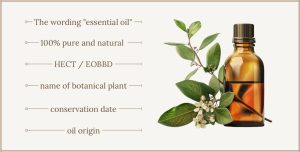Hello beautiful readers! 🤍
Embark on a journey through the aromatic world of essential oils. These will form the foundation of each beauty product that you will be able to create thanks to my upcoming DIY-Blogs (Do it yourself)!😊
You can buy essential oils in a lot of places: in supermarkets, pharmacies and parapharmacies, on the Internet, in specialty stores, in organic stores and many other places. The options are endless and they are available at a wide range of prices.

In stores you can find a lot of different essential oils. The question you should ask yourself before buying an essential oil that you will use should be:
✨how am I choosing a high-quality essential oil?✨
The composition of some essential oils can be dubious, containing toxic products, presticide residues or being composed entirely of synthetic molecules that can be harmful for health. Therefore, it is really important to inform yourself about the quality of essential oils to:
- have an essential oil for the symptoms that you want to treat
- avoid any reactions
- protect the environment
It can not only be challenging to know where to buy them, but also to recognize a high-quality essential oil. This is why I would like to share with you some tips how to recognize a good essential oil.
Tips to recognize a high-quality essential oil 🌿
Informations that should appear on the label of your bottle:

The wording “essential oil”
Essential oils are concentrated, potent substances that need to be used appropriately. Proper labeling avoids confusion with other types of oils or liquids like hydrolats or floral waters that might be used differently. This enables you to differentiate them from other products.
100% pure and natural
It is important to buy essential oils that are 100% pure, so one which is neither diluted nor blended with another component, even natural ones, otherwise they will be falsified. 100% natural indicates that no synthetic products have been add and that the essential oil has not been extracted from solvent-type products.
HECT / EOBBD
At least one of these labels should be considered: HECT “Highly essential oils chemotyped” or EOBBD stands for “Essential oil botanically and biochemically defined”. These two designations on the bottle are a real guarantee of quality in terms of the oil’s biochemistry and botany.
Name of botanical plant
The plant’s botanical name in Latin should appear to differentiate between species and varieties.
Conservation date
The conservation date should appear on the essential oils because they can degrade over time, losing therapeutic efficacy and aromatic properties. Furthermore, expired essential oils could become potentially irritating to your skin.
Oil origin
Identifying the origin of the essential oil is important because it influences their quality. Different regions may have varying soil conditions, climate, altitude, and other factors that influence the plant’s growth and the chemical profile of the oil.
I hope that my tips on selecting a high-quality essential oil have been beneficial to you! With these valuable tips in hand, you’re equipped to find a top-quality oil that suits your needs perfectly. 🥰
👉🏼 So, go ahead and click here to create your own shampoo!




Very interesting! What is your favourite essential oil? 🙂
Tea tree essential oil is amazing! It smells great and does wonders for the skin and mind.💖
Such an interesting topic! Great work – keep it up!
A very exciting and important topic! Im looking forward to reading more blogs from you!
Thank you very much!